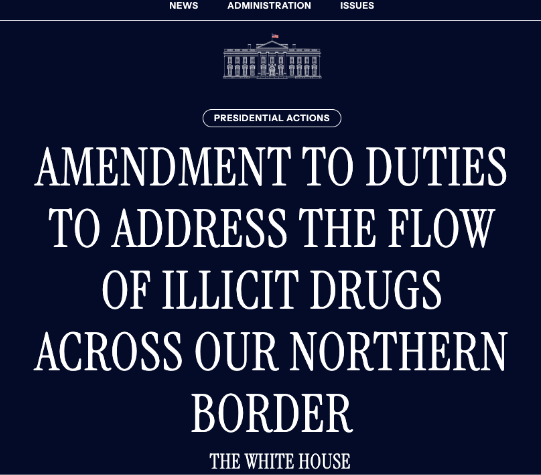[Policy Sudden Change] Cancellation of tariff exemptions at the US-Canada and Mexico borders
On March 2, local time, the Trump administration suddenly announced a major trade policy adjustment and signed two executive orders to cancel the tariff exemptions for small commodities at the US-Canada and US-Mexico borders. According to the new regulations, goods below $800 entering the United States by land from Canada and Mexico will be subject to full tariffs after the customs system is upgraded. This policy directly targets the rapidly developing cross-border e-commerce logistics channels in recent years, causing shock to the industry.
[Tough Countermeasures by Canada and Mexico] The smoke of the trade war is re-emerging
Faced with the unilateral policy of the United States, Canada and Mexico quickly took countermeasures:
Canada announced a 25% tariff on 155 billion Canadian dollars (about 107 billion US dollars) of US goods
Mexico will announce a specific countermeasure plan at 12:00 local time on March 9
It is worth noting that the US Department of Commerce released a easing signal on March 4, saying that it might announce a reduction in tariffs on the two countries on the 5th, showing the tentative nature of the policy adjustment
[Chinese cross-border enterprise alert] The countdown to the cancellation of the T86 policy has begun
The industry generally believes that the adjustment of the tariff policy for Canada and Mexico is actually a “stress test” for Chinese cross-border merchants. The cancellation of the US Customs duty-free code T86 (applicable to duty-free entry of goods below US$800) has become a foregone conclusion, and the current suspension of implementation is mainly limited by:
The upgrade of the customs clearance system has not been completed
The cross-border logistics data monitoring system needs to be improved
Although it was previously rumored that the new policy may be implemented on April 1, the official has not yet confirmed the specific timetable. Industry insiders analyzed that Chinese cross-border merchants only have a buffer period of 1-3 months.
[Industry response suggestions]
Logistics channels: accelerate the layout of overseas warehouses and reduce the proportion of direct mail
Cost control: reserve 15%-20% tariff cost space
Compliance operation: improve the product traceability system and prevent transshipment risks
Market diversification: increase the development of emerging markets such as Southeast Asia and the Middle East
[Trend analysis]
This policy change reveals the strategic intention of the United States to curb the development of China’s cross-border e-commerce. With the closure of the T86 duty-free channel, the industry will face:
Logistics costs generally increased by 20%-35%
Small and medium-sized sellers’ living space compressed
Compliance and branding transformation accelerated
Related companies are advised to immediately launch emergency plans and seize the last window of time to complete business model upgrades.








